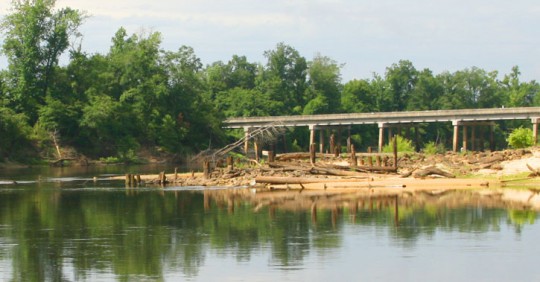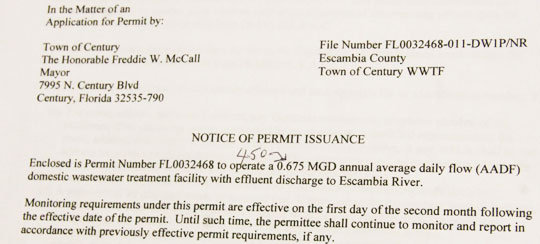State DEP Increases Century’s Wastewater Discharge Permit
December 5, 2013
A chance meeting at a conference between Century Mayor Freddie McCall and Florida Department of Environmental Secretary Herschel Vinyard turned out to be good news, and a big financial savings, for the Town of Century.
 For the past several years, Century has applied to increase their permitted treated wastewater discharge into the Escambia River. Since at least 2010, the town’s wastewater treatment plant has been at or near its 450,000 gallons per day permitted capacity. The town has applied, and been turned down, three times to increase the permitted discharge capacity.
For the past several years, Century has applied to increase their permitted treated wastewater discharge into the Escambia River. Since at least 2010, the town’s wastewater treatment plant has been at or near its 450,000 gallons per day permitted capacity. The town has applied, and been turned down, three times to increase the permitted discharge capacity.
The Florida DEP wanted Century to spend about $100,000 on testing to support the permit application, when the DEP had already done the testing, McCall said. Until his chance conversation with Vinyard, McCall said Century had been unable to convince the state DEP to use their own testing data to support the application. But he said Vinyard agreed that the DEP could use their own testing results, saving the town the $100,000, and get the permit issued.
Now, the Florida Department of Environmental Protection has increased Century’s wastewater permit to 675,000 gallons per day average, with effluent discharge into the Escambia River. The wasterwater facility already has the ability to handle the higher flow without any physical upgrades.
The new permit, McCall said, takes a big worry off his mind…if a new industry had wanted to locate in Century, the wastewater treatment plant might not have supported the industry under the previous permit.
“We welcome new industry to come to town,” McCall said. Now we are ready to take them on.”
Pictured: Highway 4 crosses the Escambia River in Century. NorthEscambia.com file photo, click to enlarge.
Comments
11 Responses to “State DEP Increases Century’s Wastewater Discharge Permit”




DEP is very stringent on Wastewater effluent discharge parameters, ensuring it is safe to go back into the environment. It is good that Mayor McCall was able to navigate the red tape even through a chance meeting to get this approved and also saved money as a bonus to make way for the future of the town. good news
Wastewater treatment plants and their disposal locations are called point-source discharges. As long as the operations are removing solids, nutrients, etc., chlorinating, and allowing water to restablish microbial life at discharge, nutrient loading should be a minor problem with increased discharge.
Of MUCH greater concern would be non-point discharges. Better known as stormwater. Any parking lots of older design lacking retention basins, along with streets and roadways, and sediment from erosion where vegetation has been cleared and not restored, are of greater concern.
More oil, nutrients, and other pollutants enter the nation’s fresh and marine water bodies through stormwater/non-point pollution than from permitted point-source discharges. If the public is concerned with the Escambia River’s well-being, non-point pollution is where the concern should be.
Yes, Florida Laws are a lot more complexed than some of Alabama’s but I can assure you as an employee of a municipality in ALABAMA, we also, by law treat our wastewater through a very complex monitoring system and supervised by a Certified Wastewater Operator before being discharged into any water way. The employees of the municipalities are mostly residents too and want to know what they are discharging is safe for their families as well as yours. When you have a few or several minutes, try visiting your local wastewater treatment facility and meet the people who take charge of your waste and thank them for the job well done, that not only protects you and your family but your community which can then increase jobs and hopefully higher pay wages.
treated wastewater is full of nutrient pollutants that cause algal blooms that kill lakes, rivers and springs. look up cyanobacteria. Modern communities build reuse facilties.
This is *TREATED* wasterwater people like the story says. it’s not raw sewage.
A half million gallons of treated water per day has to go somewhere? Where would you put it beside the river? EVERY CITY in Florida has to dump their *treated* wastewater somewhere….a lake, river, stream or bay. Pensacola’s goes into Pensacola Bay or is used at International Paper and then dumped in Perdido Bay.
It has to go somewhere and meets all the requirements of “cleaN”. It’s probably cleaner than what Alabama puts into the river.
“We welcome new industry to Century. Come here and you can pollute our river with sewage as much as you want.” Complete ignorance.
Century should be looking for other ways to dispose of waste water!! dumping it into the river is just wrong!!
Florida Department of Environmental Secretary Herschel Vinyard should make this a change in state policy.
But no, we all know the state will hold other municipalities hostage and try to force them to do duplicate testing.
How is that logjam clearing job going on the Escambia River?
Of course, if you don’t dispose of your treated waste water, you still have to do something with it. You could redrink it but if any equipment broke down, youwould be doing Isaiah 36:12 and that is unsanitary. Even if you sprayed it on fields, ultimately it will wind up in the water ways and ground water.
(All water we drink has already passed through countless kidneys)
What’s wrong with this picture. Town is happy it gets to dump an added 225,000 gallons of wastewater into the river a day. From the town’s web page ” Century is bordered by the Escambia River with boating, fishing and camping, and is home to 130 beautiful acres of fresh water known as Lake Stone, a fisherman’s paradise” I guess they just don’t get it.
I don’t think more waste water into our rivers is a great victory.